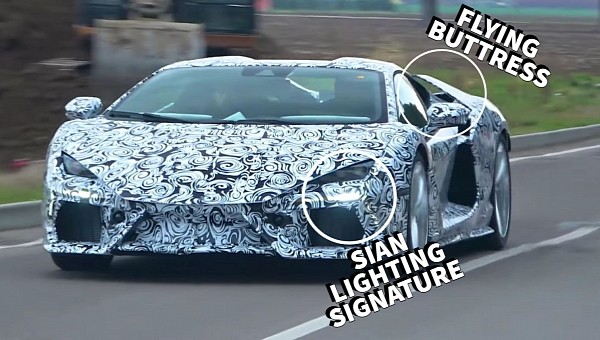Lamborghini has a long history of high-performance V12 production cars, beginning with the 350 and 400 series of grand tourers. The supercar dynasty we all know and love started with the bite-the-back-of-your-hand beautiful Miura of 1966, a transverse midship replaced by the Countach longitudinal V12 flagship.
Developed by Italian engineer Giotto Bizzarrini following his departure from the Prancing Horse of Maranello as part of the so-called Great Walkout of 1961, the Raging Bull’s original V12 would be updated time and again, growing from 3.5 liters in the 350 GT to 6.5 liters in the Murcielago and sharper Reventon.
The Sant’Agata Bolognese-based automaker developed a brand-new V12 for the recently discontinued Aventador, a 6.5 shared with the limited-run Veneno, Centenario, Countach LPI 800-4, Essenza SCV12 track-only weapon, and Sian FKP 37. The latter’s front lighting signature carries over to the long-awaited successor of the Aventador, which is rocking a different V12 mill.
Lamborghini says that it’s a clean-sheet design, most likely referring to many upgrades over the L539 engine of the Aventador and Co., including direct fuel injection or dual injection. The combustion engine is nothing to scoff at, but Lamborghini’s next-gen flagship wouldn’t be the most powerful production car to wear the Raging Bull logo without some form of electrified assistance.
Rather than a single electric motor powered by supercapacitors, the what’s-it-called supercar has been previously spied with a pair of electric motors. One drives the front wheels, whereas the other electric motor drives the rear wheel and assists the V12 powerplant.
Gifted with a pair of so-called flying buttresses, the Aventador’s replacement further sweetens the deal with a double bubble-like roof. It’s not styled by Zagato, though, but by either Lamborghini or someone at the Volkswagen Group. Scheduled to be revealed in the flesh by month’s end as a 2024 model, the PHEV supercar makes do without a driveshaft in the center tunnel, because the front wheels are now driven by an electric motor and because said tunnel is full of battery cells.
Pictured on rather mundane-looking alloys, the most powerful Lamborghini entitled to wear a license plate features a flat underbody and hexagonal-styled dual exhaust outlets. The rear deck integrates an air brake à la McLaren 765LT, and the third brake light is pretty damn sweet in its own right. The final piece of the puzzle comes in the form of a dual-clutch transmission, likely supplied by Graziano, in place of the automated manual that makes the Aventador a bit fidgety at low speeds.
Spied testing at the Sant’Agata Bolognese factory in series-production spec, the yet-to-be-named supercar needs to develop in the ballpark of 1,000 horsepower for Lamborghini to remain relevant in this ever-competitive segment. The rival to match or exceed is the Ferrari SF90 series, which is due to receive a hi-po variant in the near future, a variant referred to as the Versione Speciale.
The Sant’Agata Bolognese-based automaker developed a brand-new V12 for the recently discontinued Aventador, a 6.5 shared with the limited-run Veneno, Centenario, Countach LPI 800-4, Essenza SCV12 track-only weapon, and Sian FKP 37. The latter’s front lighting signature carries over to the long-awaited successor of the Aventador, which is rocking a different V12 mill.
Lamborghini says that it’s a clean-sheet design, most likely referring to many upgrades over the L539 engine of the Aventador and Co., including direct fuel injection or dual injection. The combustion engine is nothing to scoff at, but Lamborghini’s next-gen flagship wouldn’t be the most powerful production car to wear the Raging Bull logo without some form of electrified assistance.
Rather than a single electric motor powered by supercapacitors, the what’s-it-called supercar has been previously spied with a pair of electric motors. One drives the front wheels, whereas the other electric motor drives the rear wheel and assists the V12 powerplant.
Gifted with a pair of so-called flying buttresses, the Aventador’s replacement further sweetens the deal with a double bubble-like roof. It’s not styled by Zagato, though, but by either Lamborghini or someone at the Volkswagen Group. Scheduled to be revealed in the flesh by month’s end as a 2024 model, the PHEV supercar makes do without a driveshaft in the center tunnel, because the front wheels are now driven by an electric motor and because said tunnel is full of battery cells.
Pictured on rather mundane-looking alloys, the most powerful Lamborghini entitled to wear a license plate features a flat underbody and hexagonal-styled dual exhaust outlets. The rear deck integrates an air brake à la McLaren 765LT, and the third brake light is pretty damn sweet in its own right. The final piece of the puzzle comes in the form of a dual-clutch transmission, likely supplied by Graziano, in place of the automated manual that makes the Aventador a bit fidgety at low speeds.
Spied testing at the Sant’Agata Bolognese factory in series-production spec, the yet-to-be-named supercar needs to develop in the ballpark of 1,000 horsepower for Lamborghini to remain relevant in this ever-competitive segment. The rival to match or exceed is the Ferrari SF90 series, which is due to receive a hi-po variant in the near future, a variant referred to as the Versione Speciale.










